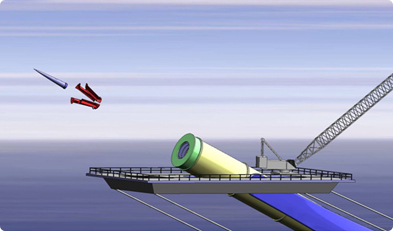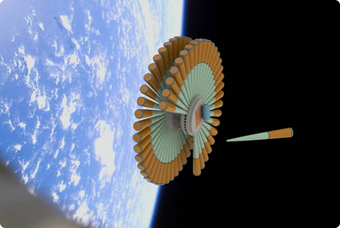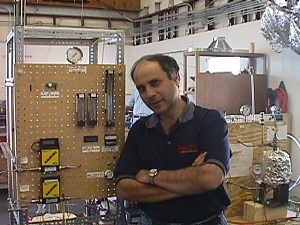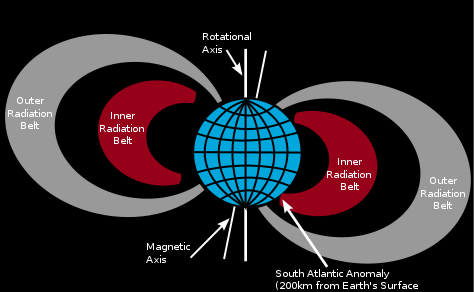Centauri Dreams
Imagining and Planning Interstellar Exploration
Report on the 2011 Mars Society Annual Convention
by Richard Obousy
After a stint as project leader for the Project Icarus starship design study, Richard Obousy now serves as Module Lead Primary Propulsion for the effort. Dr. Obousy’s doctoral work at Baylor University focused on the possibility that dark energy could be an artifact of Casimir energy in extra dimensions. For Icarus, he has pivoted to the study of fusion propulsion systems for this ongoing reworking of the original Project Daedalus concept. He’s also fascinated with the possibilities of getting off our planet more easily and establishing a human presence on Mars, all ideas he was able to explore at the Mars Society’s latest meeting, from which this report.
As a native of Texas, living only a couple of hours drive from Dallas, I was thrilled to discover that that was where the Mars Society planned to hold its 14th International Mars Society Convention. This was a perfect opportunity for me to meet space enthusiasts, to present to this community some of the ideas coming out of Project Icarus, and to learn from a successful non-profit foundation how to engage with its members, while delivering something valuable to the field of Mars research.
For those not familiar with the Mars Society, it is a non-profit charity founded in 1998 by Mars exploration luminary Bob Zubrin. The society is devoted to the cause of exploring and, ultimately settling, the red planet. The society has over 4,000 members and is active in over 50 countries worldwide. A large number of volunteers engage in public outreach programs in an effort to foster support for Mars research and exploration, and a notable feature of the society is its commitment to ongoing technical projects – the most exciting of which are arguably the research stations that the society has set up in hostile environments. The purpose of these research stations is to simulate the conditions and environment that early Mars explorers might face. Currently there are research stations in both an arctic environment and a desert environment, representing evidence for what can be accomplished by a devoted collection of volunteers.
The conference itself spanned four days, as numerous presentations relating to Mars exploration were delivered by a selection of scientists, engineers, and private hobbyists. An entire afternoon session was devoted to the topic of nuclear rockets and several of the original engineers involved in the NERVA (Nuclear Engine for Rocket Vehicle Exploration) program presented. NERVA was a fascinating facet of the US space research program, leading to nuclear rocket engines actually being certified as flight worthy in the late 60s, after extensive testing. The untimely cancellation of NERVA was largely a result of the Nixon administration’s lack of interest in the manned exploration of Mars, which it saw as both costly and strategically irrelevant, with the space race already ‘won’ after the successful Apollo moon landings.
One talk that still resonates with me was given by Dr. John Hunter, an ex-theoretical physicist turned space engineer. Hunter is the director of Quicklaunch, a company planning to use a light gas gun to launch payloads into space. The basic idea behind the gas gun is to use a large piston which imparts force to a gaseous working fluid through a smaller diameter barrel which contains the projectile to be accelerated. The gun that Hunter is working on gives the projectile, a single stage rocket engine plus payload, an initial speed of 6 km/s which launches it to approximately 100 km altitude.
Image: Quicklaunch’s larger QL-1000 systems will be built after the smaller QL-100 versions have proven high reliability. Each QL-1000 is a $500M system delivering up to 5 launches/day. After servicing one customer they can switch azimuth and launch angle to accommodate a different customer. At T=0 the vehicle leaves the muzzle and the four sabot petals are stripped away. Meanwhile the muffler closes behind the vehicle, capturing 99% of the hydrogen to be recycled. Credit: Quicklaunch.
At this point, the rocket engine fires and gives the projectile the final kick it needs to circularize its orbit. Using this technique, Hunter believes that he will be able to attain launch costs of $500/lb. Contrast this with the Space Shuttle costs of around $10,000/lb and the economics quickly makes sense. Even Elon Musk’s heavy Falcon launcher will be around the $1000/lb mark, so Hunter’s gas gun looks like an attractive option! One obvious limitation is that the high gee forces (~100 g’s) experienced during the initial launch exclude the possibility of human passengers, and so the gas gun will likely focus on launching propellant payloads. The resulting fuel ‘depots’ could enable future manned lunar and Mars exploration, if Quicklaunch were used in tandem with traditional launch systems. I encourage anyone interested in this fascinating technology to take a look at the Quicklaunch website which contains more details on their plans and accomplishments to date.
Image: Quicklaunch in Earth orbit. At T=9 minutes final maneuvering is performed until the vehicle docks with the depot. At that point a line is opened allowing the propellant to communicate with the rest of the depot. Propellant types will include both storable and cryogenics. Standard propellants are RP-1, LH2 and LOX. In addition xenon, argon and water can be delivered. Credit: Quicklaunch.
Zubrin himself gave a fascinating talk titled “VASIMR: Hoax or Silver Bullet,” arguing hotly that Chang-Diaz’s VASIMR is unlikely to produce any better efficiency than current ion engines, and that the promises being made regarding the utility of the engine are exaggerated. Zubrin believes that research into VASIMR is nothing more than a distraction, since NASA is adopting the mindset that the VASIMR is a necessary technological precursor for a manned mission to Mars. Zubrin argues that a manned Mars landing can be accomplished using off-the-shelf technology available today, for a small fraction of the $450 billion price tag that NASA initially suggested in the “90-day Study” in 1989.
Another of Zubrin’s talks, titled the “Transorbital Railroad,” urges NASA to devote a budget of $1.2 billion per year to pay for launches, possibly using SpaceX technology, to deliver payloads into orbit. The payload mass would be sold to paying customers at $50/kg, and if there were unused payload space, this could be filled with tanks containing water, kerosene and liquid oxygen. These tanks would then be left in orbit and made available to anyone who could reach them. Using the Falcon Heavy launch vehicle, Zubrin estimates that 765 metric tonnes could be launched annually. The main thrust behind this heavily government subsidized plan would be to create a space-based economic sector welcoming to entrepreneurs. His belief is that the tax revenues that would be generated from this endeavor would pay for the Transorbital Railroad many times over. The name Transorbital Railroad is adopted from the history of the settlement of the American West, where the building of the Transcontinental Railroad opened up a plethora of economic opportunities for Americans of the era.
Image: Mars Society founder Robert Zubrin. Credit: The Mars Society.
There were many more talks at the conference, equally worthy of discussion, but the ones reviewed here probably had the biggest impact on me for one reason or another. I was happy to meet with Bob Zubrin at the speakers party one night, and share with him some of the exciting work being conducted by Project Icarus, which was met with enthusiasm by Bob – a former nuclear engineer. Being involved in the area of interstellar research, I was reaching, somewhat, into a community whose goals vary from my own field. However, I felt that there was a common theme and a collective unity that binds the Mars Society with those of non-profits like the Tau Zero Foundation and Icarus Interstellar – namely a core of dedicated volunteers pushing a vision forward, while being supported by a network of collaborators spread across the globe. The success of the Mars Society is a testament to what can be accomplished by such volunteers and I was genuinely happy to be a part of that last weekend.

Heinlein and the 100 Year Starship Study
Anyone who looks back on Robert Heinlein’s ‘juvenile’ novels, twelve books written for young adults between 1947 and 1958, as inspiration for his current work gets my attention. I loved every one of those novels, particularly Citizen of the Galaxy (1957) and Starman Jones (1953), but David Neyland says it was Time for the Stars (1956) that got him thinking about the 100 Year Starship Study. If you’ve been keeping up with Centauri Dreams, you know that the Defense Advanced Research Projects Agency (DARPA), which handles cutting-edge research and development for the US military, is putting on a starship symposium this fall in Orlando, FL.
This follows up on the earlier DARPA Request for Information and will lead to the award of $500,000 or so in seed money to an organization that can best pursue the study’s goals. Neyland, who is director of DARPA’s Tactical Technology Office, has been explaining what the study is all about to newspapers like the Los Angeles Times, which ran a story on it on August 6. Heinlein’s books came up naturally in the interview, for it turns out that Neyland was quite a science fiction reader in his youth and found Time for the Stars a natural fit with his mission to inspire a new generation of scientists and engineers with the dream of starflight. The key to the linkage is Heinlein’s use of a foundation that would facilitate long-term thinking and planning.

Thus the Long Range Foundation, which in the novel creates technologies that take generations to deliver, but eventually benefit not a single government or corporation but the entire species. In the book, twins Tom and Pat Bartlett turn out to have telepathic talents that allow them to communicate with each other instantaneously, and other twins display the same gift. It’s a useful trait because it appears that using such twins is the only way to stay in touch with a far-ranging starship. Thus a representative of the Long Range Foundation comes to visit the twins and their father, where we learn about the background of the organization, as told by Tom Bartlett:
Its coat of arms reads: “Bread Cast Upon the Waters,” and its charter is headed: “Dedicated to the Welfare of Our Descendants.” The charter goes on with a lot of lawyers’ fog but the way the directors have interpreted it has been to spend money only on things that no government and no other corporation would touch. It wasn’t enough for a proposed project to be interesting to science or socially desirable; it also had to be so horribly expensive that no one else would touch it and the prospective results had to lie so far in the future that it could not be justified to taxpayers or shareholders. To make the LRF directors light up with enthusiasm you had to suggest something that cost a billion or more and probably wouldn’t show results for ten generations, if ever … something like how to control the weather (they’re working on that) or where does your lap go when you stand up.
It turns out, of course, that a foundation like this pays off in a big way, having developed a number of exploratory starships called ‘torchships’ that can reach a substantial percentage of the speed of light, more than enough for time dilation to kick in. And as the young Bartlett reflects upon a school paper he has written on it, he realizes that the Long Range Foundation (LRF) has been having the desired effect for some time:
Mr. McKeefe had told us to estimate the influence, if any, of LRF on the technology “yeast-form” growth curve; either I should have flunked the course or LRF had kept the curve from leveling off early in the 21st century – I mean to say, the “cultural inheritance,” the accumulation of knowledge and wealth that keeps us from being savages, had increased greatly as a result of the tax-free status of such non-profit research corporations. I didn’t dream up that opinion; there are figures to prove it. What would have happened if the tribal elders had forced Ugh to hunt with the rest of the tribe instead of staying home and whittling out the first wheel while the idea was bright in his mind?
Neyland credits Heinlein, then, with the notion that inspired the 100 Year Starship Study, but he also points to Jules Verne, whose From the Earth to the Moon appeared in 1865. The point of such books isn’t that they were accurate in terms of the actual technologies involved — Verne shot his crew off to the Moon from a giant cannon in ways that would have mashed them to a pulp — but that they inspired people to think about the larger topic of traveling on such a momentous journey. And Neyland noticed that it was just over 100 years later that Apollo 11 set down at the Sea of Tranquility. Like Verne, then, we may not have all the answers about starflight (to say the least) but a starship study may inspire people to ask the right questions and think big.
At a press conference in June, Neyland spoke to journalists about the study (see this Centauri Dreams story on the event), noting that in the Request for Information period that produced over 150 responses, some people had misconstrued the study’s intent. DARPA has no plans to build a starship, in other words, but to develop understanding about how research into such long range matters can be conducted, and to encourage the inevitable spinoffs as such studies are pursued. Hence the planned award to a single group that can become the locus of interstellar studies over a long time period (and if none is deemed suitable, DARPA won’t disburse the money). Here’s how he describes the study’s true goals, as told to the Times:
A lot of folks think that we’re asking for somebody to come in with a plan on how to build a starship. That’s actually the wrong answer. What we’re looking for is an intuitive understanding of the process of inspiring research and development that comes up with tangible products.
“Products” doesn’t mean physical products, but might be a new computer algorithm, a new kind of physics, a new set of mathematics, a new philosophical or religious construct, a new way of growing grain hydroponically. The organization needs to have the gestalt of how to inspire that kind of research.
Will we, in the same hundred year stretch that separated Verne from Apollo, develop the technologies we need for an actual trip between the stars? It’s an energizing thought, but from our perspective today we have no way of knowing. Nonetheless, the idea of creating an organization that can shepherd various approaches to a starship — and this is a multi-disciplinary undertaking that ranges from physics to biology to sociology and more — is one that surely captures the imagination. What spinoffs it might generate along the way are open to conjecture. Unlike so much in today’s world, the project is inherently long-term, looks out well beyond current lifetimes, and asks what will produce results not just for us but for future generations as well.
The agenda for the 100 Year Starship Study symposium is now available online [but see Jim Benford’s comment below]. And if Heinlein’s Time for the Stars is what led David Neyland to this, maybe it’s time for me to re-read it. “We know the questions to ask, but we don’t know all the questions to ask,” Neyland told the Times. “We can hypothesize where we want to get to, but it’s a pretty broad target that we’re aiming for.” A broad target indeed, and it’s high time we began gathering the resources that, if interstellar flight one day proves not just possible but practical, will eventually lead us to a mission.

Studying the Darkest World
A planet orbiting the star GSC 03549-02811, about 750 light years away in direction of the constellation Draco, is showing us a new way of extracting information about a distant system. The planet is a gas giant called TrES-2b, discovered by the Trans-Atlantic Exoplanet Survey in 2006. Studying the star using data from Kepler observations over a span of 50 orbits, David Kipping (Harvard-Smithsonian Center for Astrophysics) and David Spiegel (Princeton University) have detected the faint brightness variations caused by planetary phase changes during its orbits. The light from the planet dims and brightens as it moves through its phases around the star.
“In other words, Kepler was able to directly detect visible light coming from the planet itself,” says Kipping, and what we’ve learned is that TrES-2b is remarkably dark, reflecting less than one percent of the sunlight falling on it. The planet is blacker than any moon or planet in our solar system, as black as coal, or in Kipping’s analogy, “less reflective than black acrylic paint.” That’s quite a contrast with Jupiter, whose ammonia clouds reflect more than a third of incoming sunlight, creating a notably bright object, as anyone who enjoys taking walks at night and looking at the sky can attest.
But TrES-2b is similar to Jupiter only in its mass. This is a world that reaches temperatures of more than 1000 degrees Celsius, making ammonia clouds impossible. It’s no surprise that ‘hot Jupiters’ like this should be dark because of light-absorbing chemicals like vaporized sodium and potassium or gaseous titanium oxide in the atmosphere, all of which would lead to low albedos of a few percent. But a puzzle remains. The team went on to combine the Kepler measurements with Spitzer and ground-based data, all of which suggest, as the paper on this work reports, that there is an extra ‘absorber’ that contributes to the blackness of TrES-2b:
… models with no extra absorber are completely inconsistent with observations, even on the basis of the Kepler data alone. The upshot is that some extra opacity source appears to be required to explain the emergent radiation from this extremely dark world. Owing to this optical opacity, our models that are consistent with the data have thermal inversions in their upper atmosphere…
It’s remarkable to me that using just four months of Kepler photometry, Kipping and Spiegel have been able to detect light from the darkest exoplanet yet found. But the high-precision photometry allowed by a Kepler or CoRoT is now coming into its own, with detections already reported of phase variations for planets like CoRoT-1b, HAT-P-7b, CoRoT-3b and Kepler-7b. Thus a technique that has already been tested and refined through long use in studying eclipsing binary stars is emerging thanks to space-based instruments as a factor in understanding exoplanets, even when, like TrES-2b, they are at the very lowest limits of detectability.
The paper is Kipping and Spiegel, “Detection of visible light from the darkest world,” accepted by Monthly Notices of the Royal Astronomical Society Letters (preprint).

New Evidence for Life’s Precursors in Space
Is there a ‘goldilocks’ class of meteorite, one in which we can say that conditions were just right for producing the stuff of life? That’s one of the conclusions scientists at NASA’s Goddard Space Flight Center are reaching by studying samples taken from twelve carbon-rich meteorites, nine of them recovered from Antarctica. Their evidence shows that some of the building blocks of DNA, which carries the genetic blueprint for life, were most likely created in space before falling to Earth through meteorite and comet impacts. Thus we move closer to answering a key question:
“People have been discovering components of DNA in meteorites since the 1960’s, but researchers were unsure whether they were really created in space or if instead they came from contamination by terrestrial life,” said Dr. Michael Callahan of NASA’s Goddard Space Flight Center, Greenbelt, Md. “For the first time, we have three lines of evidence that together give us confidence these DNA building blocks actually were created in space.”
Grinding up samples of the meteorites, the Goddard team went to work with a liquid chromatograph and a mass spectrometer to separate and study the chemical structure of the compounds inside. What they found were adenine and guanine, nucleobases that connect with two other nucelobases to form the rungs of the DNA ladder. Nucleobases are essential to life. Appearing with them were hypoxanthine and xanthine, which are not found in DNA but do appear in other biological processes.
So far so good, but the question of separating these materials from possible terrestrial contamination remains. The next part of the story is thus significant. In two of the meteorites, traces of three molecules structurally similar to nucleobases showed up: purine, 2,6-diaminopurine, and 6,8-diaminopurine. This news release from GSFC points out that the latter two are almost never used in biology. Callahan says these ‘nucleobase analogs’ point to an origin in space:
“You would not expect to see these nucleobase analogs if contamination from terrestrial life was the source, because they’re not used in biology, aside from one report of 2,6-diaminopurine occurring in a virus (cyanophage S-2L). However, if asteroids are behaving like chemical ‘factories’ cranking out prebiotic material, you would expect them to produce many variants of nucleobases, not just the biological ones, due to the wide variety of ingredients and conditions in each asteroid.”
Image: Meteorites contain a large variety of nucleobases, an essential building block of DNA. (Artist concept credit: NASA’s Goddard Space Flight Center/Chris Smith).
So that’s one line of evidence pointing to a non-terrestrial origin, but usefully, it’s not the last. The next step was to analyze an eight-kilogram sample of Antarctic ice using the same methods as were used with the meteorites. The amounts of the two nucleobases, plus hypoxanthine and xanthine, in the ice were much lower than in the meteorites, and none of the nucleobase analogs were found in the ice sample. As an additional check, the team analyzed Australian soil near the fall site of one of the meteorites — the Murchison meteorite — with nucleobase analog molecules, and found none of the nucleobase analog molecules that were detected in the meteorite.
A final and compelling bit of evidence is that the GSFC team was able to produce both the biological and non-biological nucleobases in a non-biological reaction using hydrogen cyanide, ammonia and water. “This provides a plausible mechanism for their synthesis in the asteroid parent bodies, and supports the notion that they are extraterrestrial,” adds Callahan, who points to the type of meteorites known as CM2 as the ‘goldilocks’ class of meteorite, optimized to make more of these molecules. Thus the notion that the building blocks of life arrived on our planet through impacts is given a boost, one that strongly points to their non-terrestrial origin.
After all, hydrogen cyanide is common in the interstellar medium, and thus likely to produce chemical reactions on space debris. Amino acids have turned up in samples of comet Wild 2 and in various carbon-rich meteorites. The new work tells us that nucelobases, the building blocks of genetic material like DNA and RNA, can have an extraterrestrial origin in meteorites rather than being the result of contamination. The idea that the early Earth could have been seeded with these important molecules seems less speculative all the time. Says Jim Cleaves (Carnegie Institution for Science), who worked on the meteorite samples: “This shows us that meteorites may have been molecular tool kits, which provided the essential building blocks for life on Earth.”

Antimatter Source Near the Earth
Now that NASA’s Institute for Advanced Concepts (NIAC) is back in business, I’m reminded that it was through NIAC studies that both Gerald Jackson and James Bickford introduced the possibility of harvesting antimatter rather than producing it in huge particle accelerators. The idea resonates at a time when the worldwide output of antimatter is measured in nanograms per year, and the overall cost pegged at something like $100 trillion per gram. Find natural antimatter sources in space and you can think about collecting the ten micrograms that might power a 100-ton payload for a one-year round trip mission to Jupiter. Contrast that with Juno’s pace!
That assumes, of course, that we can gather enough antimatter to test the concept and develop propulsion systems — doubtless hybrids at first — that begin to draw on antimatter’s power. Bickford (Draper Laboratory, Cambridge MA) became interested in near-Earth antimatter when he realized that the bombardment of the upper atmosphere of the Earth by high-energy galactic cosmic rays should result in ‘pair production,’ creating an elementary particle and its antiparticle.
A planetary magnetic field can hold such particles in place, producing a localized source of antiprotons. The detection of antimatter in this configuration has now been confirmed by a team of researchers using data from the Pamela satellite (Payload for Antimatter Matter Exploration and Light-nuclei Astrophysics). In fact, Pamela picks up thousands of times more antiprotons in a region called the South Atlantic Anomaly than would be expected from normal particle decays.
Image: A cross-sectional view of the Van Allen radiation belts, noting the point where the South Atlantic Anomaly occurs. Credit: Wikimedia Commons.
We could go so far as to talk about an ‘antimatter belt’ around the Earth, as the paper on this work explains:
Antiprotons are… created in pair production processes in reactions of energetic CRs [cosmic rays] with Earth’s exosphere. Some of the antiparticles produced in the innermost region of the magnetosphere are captured by the geomagnetic field allowing the formation of an antiproton radiation belt around the Earth. The particles accumulate until they are removed due to annihilation or ionization losses. The trapped particles are characterized by a narrow pitch angle distribution centered around 90 deg and drift along geomagnetic field lines belonging to the same McIlwain L-shell where they were produced. Due to magnetospheric transport processes, the antiproton population is expected to be distributed over a wide range of radial distances.
The McIlwain L-shell referred to above describes the magnetic field lines under investigation. As to the South Atlantic Anomaly, it is here that the inner Van Allen radiation belt approaches the Earth’s surface most closely, which creates a higher degree of flux of energetic particles in the region. It turns out to be quite a lively place, as this Wikipedia article on the matter makes clear:
The South Atlantic Anomaly is of great significance to astronomical satellites and other spacecraft that orbit the Earth at several hundred kilometers altitude; these orbits take satellites through the anomaly periodically, exposing them to several minutes of strong radiation, caused by the trapped protons in the inner Van Allen belt, each time. The International Space Station, orbiting with an inclination of 51.6°, requires extra shielding to deal with this problem. The Hubble Space Telescope does not take observations while passing through the SAA. Astronauts are also affected by this region which is said to be the cause of peculiar ‘shooting stars’ (phosphenes) seen in the visual field of astronauts. Passing through the South Atlantic Anomaly is thought to be the reason for the early failures of the Globalstar network’s satellites.
What we’re seeing in the new work is that the Van Allen belt is indeed confining antiparticles in ways that the earlier NIAC work suggested. The antiprotons eventually encounter normal matter in the Earth’s atmosphere and are annihilated, but new antiparticles continue to be produced. The question is whether there may be enough antimatter here for hybrid missions like Steven Howe’s antimatter sail, which uses tiny amounts of antimatter to induce fission in a uranium-infused sail. James Bickford, in his Phase II study at NIAC, talked about a collection scheme that could collect 25 nanograms per day, using a plasma magnet to create a magnetic scoop that could be deployed in an equatorial Earth orbit, one that would trap incoming antiprotons.
Antimatter trapped in Earth’s inner radiation belt offers us useful savings, if Bickford is right in thinking that space harvesting will prove five orders of magnitude more cost effective than antimatter creation here on Earth. I also noticed an interesting comment in his Phase II NIAC report: “Future enhanced systems would be able to collect from the GCR [galactic cosmic ray] flux en route to further supplement the fuel supply.” Obviously, exploiting antimatter trapped near the Earth and other Solar System worlds assumes a robust space-based infrastructure, but it may be one that will finally be able to bring antimatter propulsion into a new era of experimentation.
James Bickford’s Phase II report is titled “Extraction of Antiparticles Concentrated in Planetary Magnetic Fields” (online at the NIAC site). Back in 2007 I looked at this work in three connected posts, which may be useful in putting all this in context:
- Antimatter For Deep Space Propulsion
- Finding Antimatter in the Solar System
- Collecting Natural Antimatter
The Pamela work is found in Adriani et al., “The discovery of geomagnetically trapped cosmic ray antiprotons,” Astrophysical Journal Letters Vol. 37, No. 2, L29 (abstract / preprint). See also Gusev et al., “Antiparticle content in the magnetosphere,” Advances in Space Research, Volume 42, Issue 9, p. 1550-1555 (2008). Abstract available.

Icarus Eyes Interstellar Symposium
The Project Icarus team has founded a non-profit research organization called Icarus Interstellar, its goal being to ‘foster research into those necessary technologies which can make interstellar research a reality’ through the study of such topics as fusion, nanotechnology, advanced power sources and other critical drivers for interstellar flight. We’ve tracked Icarus here from the beginning, when it emerged as an ambitious attempt to update and re-think the original Project Daedalus starship design of the 1970s. Taking fusion as its propulsion mechanism, the Icarus team now seeks to analyze and design a probe in terms of recent advances in numerous fields.
How do you go about designing a starship? Something this speculative, which must of necessity rely on extrapolations of where technology is going, happens outside the normal 9-5 workday. Centauri Dreams readers know that the Icarus team is composed of volunteers, most of whom work and exchange ideas over the Internet — only a few have actually been in the same room together. But all this is about to change. The team is now launching a fundraiser with the goal of supporting students and researchers in traveling to the DARPA/NASA 100-Year Starship Symposium, which will be held from September 30 through October 2 in Orlando, FL.
The team’s Web page supporting this effort is here, and the video below, assembled by current project leader Andreas Tziolas, offers background information. It’s especially noteworthy that Icarus now includes an active student designer program that focuses on training future generations in interstellar spacecraft design. Any funds raised through the new site will flow first to student designers who may lack the financial ability to travel to Orlando for the event.
Watching the Icarus effort grow has been inspirational –the project is now up to 35 researchers who have dedicated thousands of hours to studying the scientific constraints on a spacecraft that must attain speeds far beyond anything we have ever flown. The challenge is to design a craft that could explore a solar system within 15 light years of Earth, which involves speeds of at least 10 percent of the speed of light. We can contrast that with the current state of the art. Voyager 1, as I write this, is some 17,630,411,456 kilometers from the Sun, making about 17 kilometers per second. At that rate, 77,000 years would pass before it could cover the distance to the Alpha Centauri stars. A flyby at 10 percent of lightspeed would take less than fifty years.
Conceived as a joint venture of the Tau Zero Foundation and the British Interplanetary Society, Project Icarus has managed six conference appearances as well as 60 reports and publications in the 18 months it has been in existence, a tribute to the entire team, but especially to its first three leaders, Kelvin Long, Richard Obousy and Andreas Tziolas. If you’re not familiar with the nuts and bolts of the Icarus effort, the breakdown of its 20 research modules is available online. We now look toward Orlando and the 100 Year Starship Symposium, where Icarus team members, Tau Zero practitioners and others in the interstellar community will soon gather.








